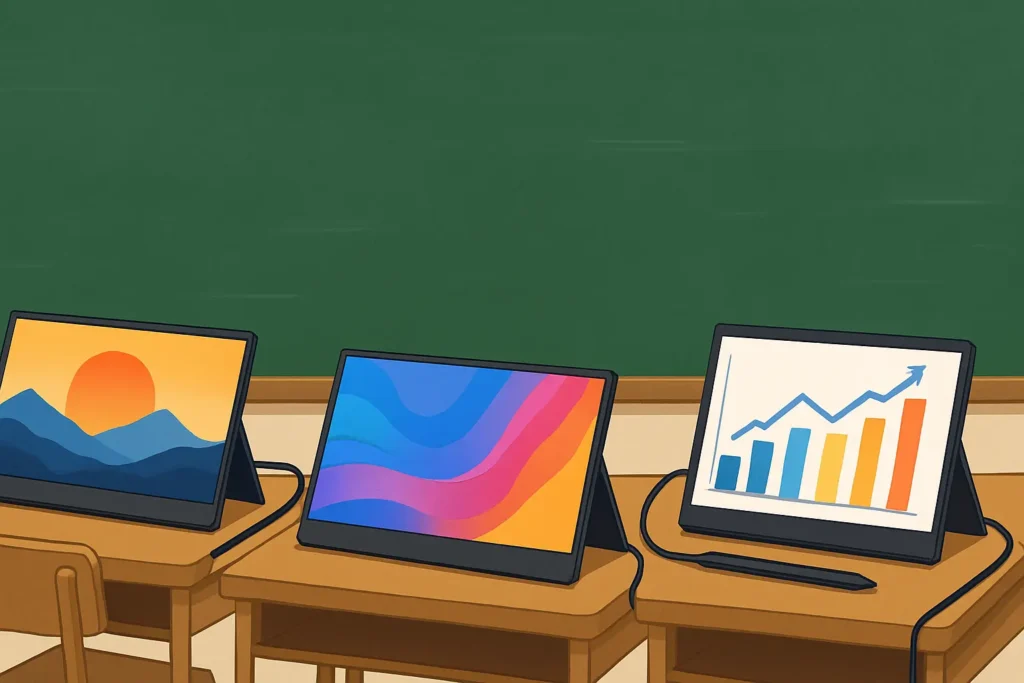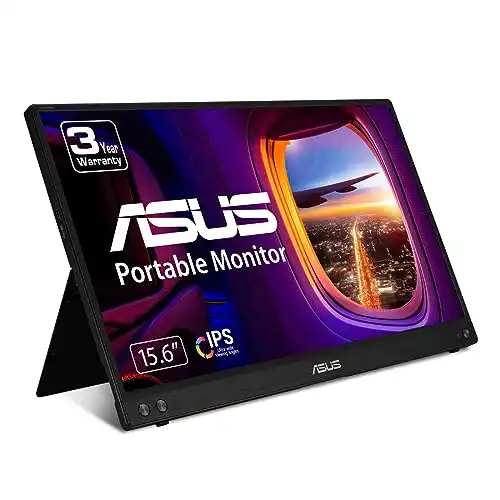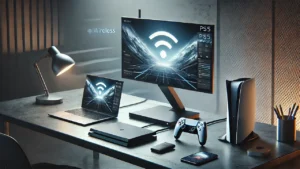Introduction to Portable Monitors
In recent years, portable monitors have gained significant traction among students and professionals alike, revolutionizing the way individuals manage tasks on the go. These compact devices are designed to offer an additional screen space, promoting enhanced productivity and multitasking capabilities while maintaining a lightweight and easily transportable form factor. With the rise of flexible work environments and the growing need for efficient study aids, portable monitors for students have become an invaluable resource.
The versatility of portable monitors cannot be overstated. They can serve a variety of applications, from sharing presentations during collaborations to providing extra screen real estate for coding or graphic design. Many students have found that integrating a portable monitor into their study routines allows for better organization and focus. With the ability to connect to laptops, tablets, and even smartphones, these monitors enable seamless transitions between settings, whether at home, in the library, or even in a coffee shop.
Another notable benefit of portable monitors is their ease of use. Most modern portable monitors feature plug-and-play functionality, meaning that users can set them up quickly without the need for complicated installation processes. This inherent simplicity is particularly beneficial for students, who often find themselves balancing multiple commitments and require tools that do not add to their workload. Furthermore, the lightweight nature of these devices makes them an ideal companion for any student who needs to carry their study essentials in a backpack.
Ultimately, as the demand for flexible studying and working solutions grows, portable monitors for students stand out as an essential tool. They provide not only additional functional screen space but also cater to the increasing expectation of mobility and efficiency in today’s fast-paced educational and professional environments.
Why Portable Monitors are Essential for Students
As educational demands evolve, so too do the tools that facilitate learning. For students navigating academic responsibilities, portable monitors have emerged as vital assets, offering a multitude of advantages that enhance their educational experiences. One of the key benefits portable monitors for students provide is the capability to improve multitasking. By extending their display space, students can efficiently manage multiple applications simultaneously. This capability is particularly beneficial during research or writing assignments, where access to reference materials alongside drafting software can significantly streamline the process.
Moreover, the flexibility of creating dual-screen setups with laptops transforms how students interact with their coursework. With a portable monitor, students can project lectures on one screen while taking notes on the other. This dual-display setup not only allows for better organization of information but also reduces the need for constant switching between tasks, leading to improved focus and productivity. Real-world examples of students using dual-screen setups are prevalent; a group of engineering students found that utilizing a portable monitor while collaborating on projects improved their efficiency, enabling quicker access to design software and research articles.
Additionally, portable monitors offer enhanced learning experiences, particularly crucial in today’s digital learning environments. In online classes, students can engage more effectively when they can view the instructor’s presentation on one screen while participating in discussions or applying concepts on another. This dual-screen approach fosters an interactive learning atmosphere, encouraging engagement and active participation. For example, a student might follow along with a programming tutorial on one screen while coding on the other, helping to reinforce their understanding of complex concepts.
In conclusion, portable monitors for students deliver essential advantages that bolster academic productivity, enhance learning experiences, and facilitate effective multitasking. As students increasingly adapt to diverse learning environments, investing in a portable monitor becomes a strategic decision to support their educational journey.
Key Features to Look For in a Portable Monitor
When selecting portable monitors for students, it is essential to consider a variety of features that significantly influence usability and overall experience. One of the key attributes is screen size. A portable monitor typically ranges from 13 to 17 inches, providing enough screen real estate for multitasking without being overly cumbersome. A larger display can enhance productivity, especially for tasks such as writing papers or presenting presentations.
Another critical aspect is resolution. While many portable monitors offer Full HD (1920 x 1080), higher resolutions like 4K can provide sharper images and text clarity, which is particularly beneficial for students needing to edit graphics or watch high-definition videos. The clarity of the display is crucial, as it affects visual comfort during extended usage periods.
Connectivity options are also a vital consideration. Ensure that the portable monitor supports various ports such as HDMI, USB-C, or DisplayPort to ensure compatibility with different devices, including laptops, tablets, and smartphones. This flexibility facilitates seamless integration into a student’s tech ecosystem, enhancing overall usability.
Weight and portability are crucial features for students who may need to carry their devices around campus. Opt for monitors that are lightweight and slim, making them easy to transport in a backpack. Typically, monitors weighing less than two pounds strike a good balance between portability and usability.
Lastly, battery life plays a significant role in the practical use of portable monitors for students. Monitors with built-in batteries offer the convenience of usage without dependence on a power source, allowing students to work in various environments such as libraries or coffee shops. Features such as energy efficiency can extend usage time, ensuring that students remain productive throughout their day.
Top Portable Monitors for Back-to-School 2025
As the back-to-school season approaches, students are increasingly seeking tools that can enhance their learning experience. Portable monitors for students provide an excellent solution by allowing for greater flexibility in multitasking and improving overall productivity. Here is a curated list of the top portable monitors recommended for the 2025 academic year, each showcasing unique features tailored to the needs of students.
The ASUS ZenScreen MB16AC stands out as a leader in the portable monitor category. Weighing just 1.76 pounds, this 15.6-inch Full HD display offers a quick USB Type-C connection, making it easy to plug into laptops or tablets. Its lightweight design and integrated smart cover make it exceptionally transportable for students who move between classes. With good color reproduction and a 60Hz refresh rate, it is suitable for both academic tasks and leisure activities.
Another noteworthy option is the Lenovo ThinkVision M14. This 14-inch portable monitor is not only compact but also features a unique adjustable hinge that allows for multiple viewing angles. It has two USB Type-C ports for easy connectivity and provides excellent brightness and color accuracy. These features make the Lenovo ThinkVision M14 an excellent companion for students who require a reliable second screen for data analysis or group projects.
Lastly, the HP EliteDisplay S14 is a strong contender with its sleek design and impressive resolution. This 14-inch monitor is designed with portability in mind, incorporating a protective sleeve that serves both as a stand and for transport. It offers an efficient USB-C connection and reacts well to different lighting environments, ensuring students maintain visibility whether in the library or a coffee shop.
When considering portable monitors for students, each of these models brings unique benefits to the table, making them valuable assets for enhancing academic performance and convenience during the school year.
Our Rating:
4.3 | Our Rating:
4.4 | Our Rating:
3.5 |
$209.00
| $219.00
| |
Budget-Friendly Options for Students
As students gear up for the back-to-school season, finding cost-effective solutions without sacrificing quality is a top priority. Portable monitors for students can be an invaluable asset, enhancing productivity and educational experiences. Fortunately, there are several budget-friendly options that cater specifically to the needs of students.
The AOC e1659Fwu is one such model that combines affordability with performance. This 15.6-inch portable monitor connects via USB 3.0, which increases its compatibility with most laptops, making it a versatile choice for classroom and home study. With a resolution of 1366×768, it provides decent picture quality for presentations and everyday tasks. Its lightweight frame is also convenient for students who are often on the move.
Another excellent option is the Lepow Z1. This 15.6-inch display features a full HD resolution (1920×1080), delivering sharp images and vibrant colors, making it suitable for video watching and gaming during breaks. The Lepow monitor is notably lightweight and comes with a smart cover that doubles as a stand, offering convenience for students who need to set up quickly in different environments.
For those looking towards a cost-effective yet expansive option, the Asus ZenScreen MB16AC offers a 15.6-inch display with a full HD resolution and USB-C connectivity. This monitor allows seamless connection to modern devices, catering to tech-savvy students who may be using various equipment. Its foldable design enhances portability, ensuring that students can carry it without hassle.
Lastly, the GeChic 1101P presents a dynamic touch option that caters to interactive learning experiences. This model features a 11.6-inch IPS screen with 1920×1080 resolution, making it compact yet efficient. Its connectivity options include HDMI and VGA, making it adaptable to various setups. These monitors exemplify the best portable monitors for students, offering functionality at reasonable prices, ensuring that academic pursuits remain accessible to all.
$99.99
| $170.56
| $99.99
| $77.99
|
Description:
A slim 15.6" Full HD IPS monitor with USB-C and HDMI for easy plug-and-play use. Features a matte screen for glare reduction, built-in stereo speakers, and a smart magnetic cover that doubles as a stand. | Description:
This 15.6″ Full HD IPS monitor runs on a single USB 3.0 cable for both power and display. Ideal for business users, it features a built-in stand and supports both portrait and landscape modes—no extra cables needed. | Description:
A slim and lightweight 15.6″ 1080P monitor with HDR support, USB-C/HDMI compatibility, and an integrated kickstand—perfect for work, play, or travel on a budget. | Description:
An affordable 15.6″ Full HD HDR monitor with dual USB-C, HDMI, eye-care display, and built-in speakers—ideal for daily work, gaming, and travel setups. |
Rate:
4.0 | Rate:
4.2 | Rate:
4.2 | Rate:
4.4 |
How to Set Up and Use a Portable Monitor
Setting up a portable monitor is a straightforward process that enhances the productivity of students by providing additional screen space. The first step involves ensuring compatibility with the devices you intend to use, such as laptops, tablets, or even smartphones. Most portable monitors are designed to be versatile, supporting connections with various devices, but checking the specifications beforehand is advisable.
Once you have confirmed compatibility, the next stage is to choose the appropriate connection method. The most common connection types for portable monitors for students are HDMI and USB-C. If your device has an HDMI port, you can connect it directly to the monitor using an HDMI cable. For devices with USB-C ports, this method provides a two-in-one solution, transmitting both power and data simultaneously. It is essential to use the correct type of cable, as some USB connectors vary in function and may not support video output.
After connecting the monitor, power it on and, if necessary, adjust the display settings on your primary device. You can typically do this through the display settings in your operating system, where you can choose to extend or mirror your screen. Extending the screen allows for a more spacious workspace, helping to manage multiple applications simultaneously, while mirroring is useful for presentations or collaborative work.
To optimize your workspace while using a portable monitor, consider adjusting the physical setup. Ensure that the monitor is at eye level and positioned to minimize glare from overhead lights. To further enhance the experience, take advantage of software tools designed for multitasking, such as virtual desktops or task organizers. The combination of an efficient physical setup with optimized software functionality can significantly improve the workflow for students using portable monitors.
Reviews from Students and Professionals
The utility of portable monitors for students has garnered many positive testimonials from individuals in academia and the workplace. Students frequently highlight how these devices enhance their productivity, allowing them to manage multitasking efficiently. For instance, Jessica, a recent college graduate, notes that using her portable monitor while studying made it significantly easier to view lecture notes and research simultaneously. “Having two screens meant I could keep my resources organized without constant switching,” she explains, emphasizing the practicality that these monitors brought to her study routine.
In professional environments, the benefits of a portable monitor are equally apparent. Tom, a freelance graphic designer, attests that the additional screen space has allowed him to improve his design workflows. “Portable monitors for students aren’t just for school; they have proven to be invaluable in my professional life as well. I can have my design software open on one screen while referencing client feedback on the other,” he shares. This feedback illustrates how portable monitors offer flexibility and functionality, allowing for a seamless shift between study and professional assignments.
Where to Buy: Online vs. In-Store
When considering the purchase of portable monitors for students, one of the first decisions to make involves choosing between online shopping and in-store buying. Each option carries its own set of advantages and disadvantages that can significantly affect your purchasing decision, particularly when it comes to factors such as pricing, availability of student discounts, and return policies.
Shopping online for portable monitors offers convenience, allowing students to explore a broader range of models and brands from the comfort of their homes. Major e-commerce platforms, such as Amazon, often showcase various portable monitors, ensuring competitive pricing and exclusive online discounts. Additionally, many retailers extend student discounts, enabling cost-effective options for essential school supplies. Online reviews and product comparisons further assist in making informed decisions, as potential buyers can easily gauge the performance and reliability of different models.
However, when opting for an in-store purchase, there are unique benefits that might appeal to some students. Firstly, the ability to physically inspect the monitor can be invaluable. Shoppers can assess the display quality, size, and build before making a commitment. Moreover, in-store shopping often allows for immediate purchasing, eliminating the wait times associated with shipping. Some retail locations may also offer clearance sales or additional in-store promotions that provide an opportunity for significant savings.
In terms of return policies, online purchases may feature more flexible options; however, it’s crucial to read the terms and conditions carefully, as they can vary widely among retailers. Conversely, buying in-store might allow for easier returns if a monitor does not meet expectations. Considering these aspects is vital for students who rely on portable monitors for their academic success.
Ultimately, the choice between online and in-store purchasing will depend on individual preferences and priorities. For tech-savvy students keen on finding the best deals, buying now on Amazon could prove to be the most advantageous strategy, especially before student deals and discounts expire.
Read also:
The Best Portable Monitors for Gaming: Top 10 Choices
Conclusion
In the ever-evolving landscape of education, portable monitors for students have become indispensable tools that enhance the learning experience. As we have explored throughout this blog, the right portable monitor not only expands screen real estate but also fosters improved organization and productivity for students. By allowing for multitasking capabilities, these monitors can help students manage their studies more effectively, whether it’s for taking notes, conducting research, or collaborating on group projects.
We have highlighted various models that cater to different needs, preferences, and budgets, making it crucial for students to assess which portable monitor aligns best with their specific study habits and academic requirements. From features such as screen size and resolution to connectivity options, selecting a monitor that complements a student’s lifestyle can significantly impact their overall educational outcomes.
As the back-to-school season approaches, potential buyers should act promptly to take advantage of upcoming sales and discounts on portable monitors for students. Quality monitors can often be found at competitive prices, but these deals may not last long. Therefore, it is advisable to make a well-informed decision based on the information presented in this post and prioritize investing in a device that enhances their study environment.
Ultimately, embracing the right technology, such as portable monitors, can provide students with the flexibility and efficiency they need to thrive academically. Being proactive in acquiring these tools will undoubtedly allow them to make the most of their educational journey as they gear up for the new academic year.










